List of Authors
>>About this blog
Recent blog post
|
[Minato kid]
December 13, 2018 12:00
 Hello, this is Minato kid. Hello, this is Minato kid.
Today, I would like to walk along the green path in front of St. Luke Garden.
The planting in the sidewalk is lush, small waterways run, and cherry blossom trees are beautiful in spring.
Let's visit the precious remain and monuments that tell you that there was Tsukiji foreign settlement in Meiji period here in Akashicho.
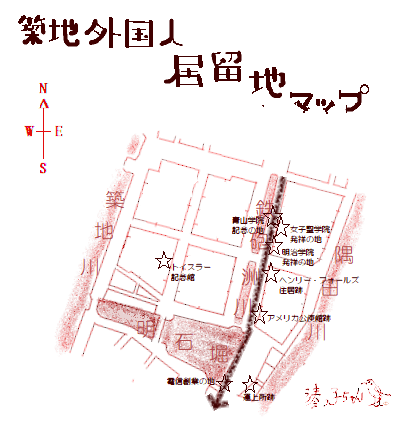
 ♪ Toysler Memorial Hall ♪ Toysler Memorial Hall
In 1933 (1875), a missionary hall of St. Luke International Hospital was built on the banks of the Sumida River. J. Bergamini was also involved in the design of St. Luke's International Hospital. It is a two-story building made of reinforced concrete, partially wooden, and is a solid stately building reminiscent of a European mountain villa.
The exterior has a half-timber-style design that expresses pillars and beams, and the interior has a tuder-Gothic style, the entrance and living room, etc., with a solid wood interior. It was relocated and restored in 1998 and is now located in the courtyard of St. Luke's International Hospital.
 ♪ U.S. ♪ U.S.
In 1859 (1859), Harris, the first American minister, opened the American ministerial office in Zenpukuji, Minato-ku. Then, the following year, a new envoy was built on the Tsukiji foreign settlement, and the shape was adjusted here. It is said that it was a wooden two-story, cream-colored Western-style building.
In 1890 (1890), I moved to Akasaka, the current location of the American Embassy. On the site of the Tsukiji foreign settlement, there were five monuments made of Komatsu stone. A pattern symbolizing the United States is engraved on a stone about 1m square.
Two monuments are preserved in the courtyard of St. Luke's Garden, three in front of St. Luke's International Hospital courtyard and in front of the Toysler Memorial Hall.
 ♪ The ruins of Henry Falls residence ♪ The ruins of Henry Falls residence
Henry Falls, a missionary physician of the Scotland Conforming Elders, lived here during his stay in Japan from 1874 (1874) to 19 (1886).
I was interested in the practice of fingerprinting in Japan and conducted scientific fingerprint research. In 1880 (1880), a paper submitted to the British magazine Neurea is said to be the world's first paper on scientific fingerprinting, in which he presented his personal identification experience of criminals and referred to the genetic relationship of fingerprints. Later, in 1911 (1911), the Japanese police adopted the fingerprint method for the first time.
♪ Monument on the banks of the Sumida River

1.Monument at the site of the Tsukiji Unjosho
In 1867 (1867), the Edo Shogunate designated the whole area of Akashicho, Tsukiji Gunsho, as a permanent residence for foreigners in Tsukiji, and established a luck office for customs duties. This is the beginning of Tokyo Customs.
2.Local monument founded by telegraph
In 1869 (1869), the construction of a telegraph line of about 32 km was started connecting the Yokohama Court and the transmission station office located in Tsukiji Unjo, Tokyo. Started operations in December of the same year. It was Japan's first public telecommunications and played a major role in Civilization and enlightenment.
♪ School monument

1.Aoyama Gakuin Memorial Monument 1877 (1877)
2.Monument of the birthplace of Meiji Gakuin, 1877 (1877)
3.Monument of Birthplace of Women's Seigakuin 1905 (1905)
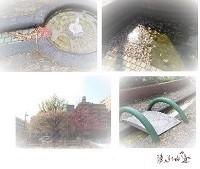 In spring, Minatoko likes the appearance of cherry blossom petals floating on the sparkling water surface. In spring, Minatoko likes the appearance of cherry blossom petals floating on the sparkling water surface.
There is a small fountain in the waterway, and there is a pretty bridge that stretches in just a step.
This is an unnamed road, but it is a unique street that delights the walkers.
Correspondent Minato kid, Chuo-ku Tourism Association

No. 29 December 9, 2018
[Minato kid]
December 3, 2018 12:00

Hello, this is Minato kid.
Today, I would like to walk "Idomechi Chuo-dori" from Tsukiji 6-chome 4 to Minato 1-chome 1. This street is the newest street in the Kyobashi area, nicknamed in 2013. Recently, Tokiwa Japanese dogwood trees have been planted on the sidewalks in the Irifune and Minato areas where maintenance has been completed.
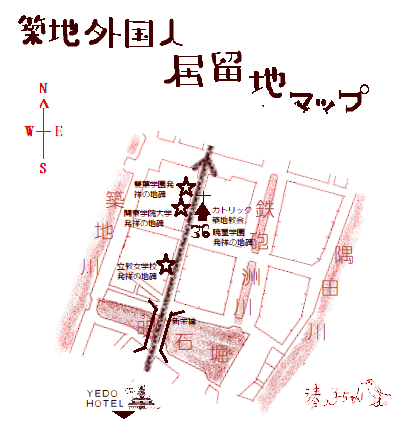
♪ YEDO HOTEL
The parking lot in Tsukiji Market, facing Harumi-dori St., is the place where the warship training center used to be.
After Perry's arrival of the Black Ship fleet, Edo shogunate, faced by the need for a Western Navy, began in 1857 (1857) at the Tsukiji Kobusho.
They gathered applicants from flagship books, family members, and various clansman to practice navigation and marine artillery, as well as practice driving warships imported from the Netherlands.
In 1865 (1865), it was renamed the Naval Office, but due to burning, it moved to the current site of the former Hamarikyu Garden.
In 1868 (1868), the new government notified the opening of Tokyo to each country, and Tsukiji foreign settlements were established in the current Akashicho area. The Tsukiji Hotel Building, which was built on the site of the Navy's site, was also called "Foreign Ryokan" and "YEDO HOTEL (Edo Hotel)" and opened as a lodging facility for foreigners who visited on trade.
 The design and construction was considered to be Kisuke Shimizu, and it was a large hotel with a wooden two-story building and 102 guest rooms. The design and construction was considered to be Kisuke Shimizu, and it was a large hotel with a wooden two-story building and 102 guest rooms.
The outer wall was namako wall, each room was equipped with fireplaces, and a veranda on the coast, giving a panoramic view of Tokyo Bay.
What is impressive is that there is a tower in the center of the building, where a bell is hung there, and the tower is symmetrical, centering on the tower.
This is a typical feature of "pseudo-Western style (opening type) architecture", which was seen in various places until the Meiji 20s. The exterior is Western style, but the building materials and techniques are Japanese style.
However, in 1872 (1872), the Tsukiji Hotel Building was burned down due to the great fire in Ginza.
 ♪ The entrance to Tsukiji Foreign Settlement ♪ The entrance to Tsukiji Foreign Settlement
Well, I went to Akatsuki Park. The area around Akatsuki Park today was once a large moat called "Akashibori". The center was Shin-ei Bridge, which was the gateway to foreign settlements.
Remaining Chuo-dori is dressed as crossing the former Shin-ei Bridge. Many foreigners from Shimbashi crossed this bridge by carriage and entered the Tsukiji foreign settlement.
 ♪ Catholic Tsukiji Church ♪ Catholic Tsukiji Church
A small church surrounded by trees stands quietly at the former settlement No. 36, which crosses St. Luke Street and crosses Reservation Street. It's Catholic Tsukiji Church.
The Catholic Tsukiji Church was built in 1874 (1874) as the first church in Tokyo on the Tsukiji Foreign Settlement. The original name is Tsukiji St. Joseph Cathedral. It was also the first cathedral in Tokyo (bishopedral).
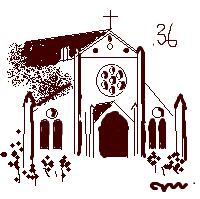 In 1878 (1878), a Gothic-style red brick cathedral was built. In 1888 (1888), Xiaosei Gakuen originated in the sacred school. However, it was burned down by the Great Kanto Earthquake. The current cathedral was rebuilt in 1927 (1927) under Father Gyrodias. In 1878 (1878), a Gothic-style red brick cathedral was built. In 1888 (1888), Xiaosei Gakuen originated in the sacred school. However, it was burned down by the Great Kanto Earthquake. The current cathedral was rebuilt in 1927 (1927) under Father Gyrodias.
At the request of Archbishop Ray, the Greek Parthenon style was adopted, and the Doris order column, pediment, is engraved with tulips and roses.
The Akashicho area has escaped air raids, and the Catholic Tsukiji Church is one of the oldest churches in Tokyo and conveys its magnificent appearance today.
 What is preserved in the cathedral is the Angelas bell, nicknamed "Janne Louise of Edo". It was given by Renne, France in 1876 (1876), and was a pair of two large and small bells. Louise is the smaller one. The large Josephine moved to Sekiguchi Church with the Archbishop in 1920 (1920). What is preserved in the cathedral is the Angelas bell, nicknamed "Janne Louise of Edo". It was given by Renne, France in 1876 (1876), and was a pair of two large and small bells. Louise is the smaller one. The large Josephine moved to Sekiguchi Church with the Archbishop in 1920 (1920).
♪ A monument built on the settlement Chuo-dori street
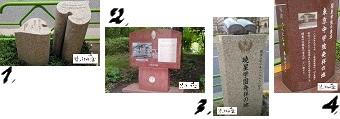
1.In 1881 (1881), the monument of the opening of Futaba Gakuen.
2.1882 (1882) Monument of the opening of Rikkyo Girls' School
3.1888 (1888) Monument of the birthplace of Xiaosei Gakuen
4.Monument of the birthplace of Kanto Gakuin University in 1895 (1895)
In addition, outside the settlement, there was a "relative leased land area (miscellaneous land)" that was allowed to rent a house to foreigners. It seems that many foreigners did not live in the settlement and lived in this area.
As for the relative leased land, along the settlement Chuo-dori, the current Tsukiji 6-chome / 7-chome, Irifune / Minato area, and Shintomi-cho corresponded.
Even now, there is an alley in the Irifune area where you can see the cross of St. Luke's International Hospital straight. It is nicknamed "Cross Street" by local residents.
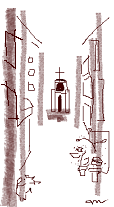
Correspondent Minato kid, Chuo-ku Tourism Association

No. 28 December 2, 2018
[Minato kid]
Nov. 26, 2018 14:00
 Hello, this is Minato kid. Hello, this is Minato kid.
Today, I would like to walk "St. Luke Street" from Tsukiji 3-chome 8 to Akashicho 9.
The sunbeams on St. Luke Street is the dogwood, which was given by the United States as a sign of friendship.
From 1868 (1868) to 1899 (1899), Tsukiji foreign settlements were set up in the current Akashicho area, where many missionaries and doctors lived, and became a base for missionary activities in Japan. . It is an area closely related to the United States, such as the establishment of the United States Mission in 1875 (1875).
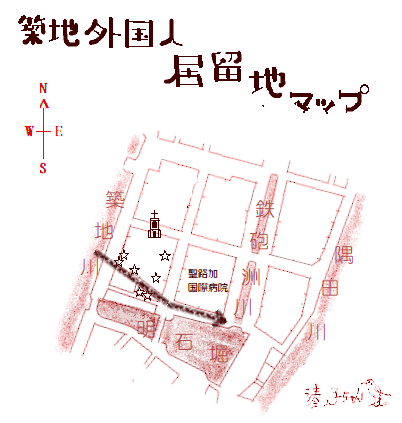
 ♪ Symbol of Akashicho St. Luke's ♪ Symbol of Akashicho St. Luke's
In 1900 (1900), a missionary doctor R. B Toysler came to Japan, and in 1934, Tsukiji Hospital was renamed St. Luke Hospital and launched. In 1937, St. Luke's Nursing School was opened, and the three basic structures of Toysler's aim of religion, medical care, and nursing education were established, and St. Luke's Hospital has developed significantly since then. In 1917 (1917), he changed his name to St. Luke's International Hospital.
The construction of St. Luke's International Hospital was originally designed by A. Raymond. Later, it was entrusted to J. Bergaminy, and in 1936 (1936), the Neo Gothic St. Luke Chapel was built. Even now, from the chapel, the sound of the bell echoes on time every day, reminiscent of the former foreign settlement era in Akashicho and surrounding areas.
♪ Monument on St. Luke Street

Monument of origin of Dutch studies
Ryotaku Maeno, a physician and orchid scholar of the Okudaira family of the Nakatsu clan in Buzen (now Oita Prefecture), translated the Dutch medical book "Tarher Anatomia" along with Genpaku Sugita, Junnan Nakagawa, Hoshu Katsuragawa and others. In 1774 (1774), "Dismantling New Book".

Monument of the birthplace of Keio Gijuku
Yukichi Fukuzawa (1835-1901), a native of the Nakatsu clan, opened a Dutch school in this area in 1858 (1858) and developed into the current Keio University.

Monument of the Birthplace of Women's Academy
In 1870 (1870), missionary Julia Karo Sols founded A6 Women's School, the predecessor of the Women's Academy. Tsukiji This Western-style building was built for the first time in a foreign settlement, attracting the attention of people. (Different from the actual old location)

Monument to the birthplace of Rikkyo Gakuin
In 1874 (1874), Primate C. M Williams opened a private school, Rikkyo School, the roots of Rikkyo Gakuin.

Toysler Memorial Hall
It was built in 1933 as a missionary building at St. Luke's International Hospital. On the exterior, you can see a Western-style architectural design that expresses the framework of pillars and beams. At present, it has been relocated and restored to the courtyard in the hospital.

Monument to the site of Takumi Asanouchi's residence
This is the site of the residence of Chushingura's famous Akaho feudal lord Asanouchi Takumi Naganori. In 1701 (1701), a sword wound incident that occurred in Edo Castle was ordered to be silent and his house was cut off.

Information board for the birth of Ryunosuke Akutagawa
Ryunosuke Akutagawa (1892-1927) was born here in 1892 as the eldest son of a milk ranch called Komakisha. He entered the gate of Soseki Natsume and left many works, such as "Kappa", "Rashomon", and "The Life of Anime".
♪ Welcome to the sidewalk museum!

It's a fashionable place to tell the former Tsukiji foreign settlement, such as a picture of a gas lamps and the address of the settlement. (Photo taken in April 2018)
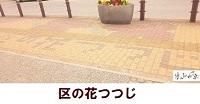
On the sidewalk of the former Akatsuki Bridge, there are letters "flower azaleas in the ward" shaped by pavement blocks and pictures of azaleas.
 The colorful objects on the bridge are inspired by the wind. From this year, a new flower bed at the “Flowering Town Corner” has been set up, and it is a lively street, coupled with the lively traffic of people. The colorful objects on the bridge are inspired by the wind. From this year, a new flower bed at the “Flowering Town Corner” has been set up, and it is a lively street, coupled with the lively traffic of people.
Correspondent Minato kid, Chuo-ku Tourism Association

No. 27 November 23, 2018
[Minato kid]
Nov. 8, 2018 14:00
 Hello, this is Minato kid. Hello, this is Minato kid.
Today, I would like to walk "Idomechi Street" from Akashicho No. 1 to Akashicho No. 8. In Meiji period, there was a Tsukiji foreign settlement in the current Akashicho area.
♪ Edo shogunate and the opening of the country
In 1858 (1858), the Edo shogunate signed the United States and Japan-U.S.-Osamu Treaty of Commerce and Trade with the United States, halted its isolation and began to substantially open its doors. In the same year, it was concluded with the Netherlands, Russia, U.K. and France, and this is called the "Ansei Five-Party Treaty".
Based on this treaty, five ports were opened: Hakodate (Hakodate), Kanagawa (Yokohama), Niigata, Nagasaki, and Hyogo (Kobe), and Edo and Osaka (Osaka) were opened.
By the way, the difference between opening a port and opening a city is that opening a port was allowed to enter and exit foreign ships, while opening a port is not allowed to enter and exit foreign ships. Therefore, for the convenience of commercial transactions, it was necessary to open the market close to the opening of the port.
In addition, foreign settlements in Japan have been set up at the opening and opening markets as special special wards for the residence of foreigners in countries concluding the treaty and commercial transactions.
In 1870 (1870), it was finally maintained "Tsukiji Foreign Settlement", but it was not only late to Yokohama, which had already developed as a port opening, but in 1872 (1872), the railway between Shimbashi and Yokohama Then, foreign merchants did not live in Tsukiji and started to do business on a day trip from Yokohama.
As a result, many people did not gather in Tsukiji foreign settlements. However, this brings a unique culture to Tsukiji foreign settlements and forms a district that has a great influence on the modernization of Japan.
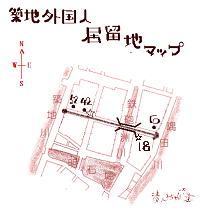 ♪ Characteristics of Tsukiji Foreign Settlements ♪ Characteristics of Tsukiji Foreign Settlements
While Yokohama and Kobe have developed as trade towns, missionaries, teachers, doctors, etc. gradually began to live in Tsukiji foreign settlements, becoming a base for missionary activities in Japan, and missionary halls and churches are lined up. I have deepened my cultural color.
The removal of the high bill for Christianity banned in 1873 (1873) can also be said to have supported such missionary activities.
 Missionaries built churches on their own, created sacred schools and mission schools, and worked on missionary activities while also contributing to medical and charitable activities. Tsukiji There are 13 religions born in foreign settlements, and 13 schools also originated here. Even today, many of the famous schools have originated here in Tsukiji foreign settlements. In addition, there were 10 churches, and the streets with exotic atmosphere were created. Missionaries built churches on their own, created sacred schools and mission schools, and worked on missionary activities while also contributing to medical and charitable activities. Tsukiji There are 13 religions born in foreign settlements, and 13 schools also originated here. Even today, many of the famous schools have originated here in Tsukiji foreign settlements. In addition, there were 10 churches, and the streets with exotic atmosphere were created.
 ♪ The brick walls and gas lamps that still remain ♪ The brick walls and gas lamps that still remain
The addresses in Tsukiji foreign settlements were from 1 to 52. Among them, the brick wall that was built between the adjacent "No. 52" and "No. 42" remains. At present, the fire department and the school grounds of Akashi Elementary School are lined up.
From 1878 (1878) to 1899 (1899), "No. 52" had the Church of St. Paul. "No. 42" had Shinei Girls' School from 1876 (1876) to 22 (1889), and Tokyo Junior High School from 1895 to 32. This  brick wall is characterized by a stacking method called "English style". brick wall is characterized by a stacking method called "English style".
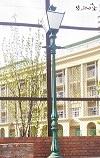 There are also gas lamps that are thought to be from the end of the Meiji era. There are also gas lamps that are thought to be from the end of the Meiji era.
It is made of colint-type cast iron and has distinctive decorations such as armpits spread to the left and right and belt-shaped decorations seen below it. You can see how the lighting part was later used as an electric light. Even now, when the sun goes down, the lights are shining, reminiscent of the former settlement period.
Once on the main street (Akashicho Ryokudo), Urahori Bridge used to be built. It was the Tepposu River that flowed down. Crossing this bridge, on the left is the Tokyo Matching Shrine, the predecessor of Meiji Gakuin University, headed to the Sumida River, followed by B6 Women's School and A6 Women's School.
A6 Women's School was located on the shores of the Sumida River, the settlement "No. 6". Founded in 1870 (1870) by Missionary Julia Karo Sols, it is later a girls' school. Tsukiji This Western-style building was built for the first time in a foreign settlement, attracting the attention of people.
 ♪ Henry Falls and Medical Activities ♪ Henry Falls and Medical Activities
Crossing Urahori Bridge, on the right hand side was the residence of Henry Falls (1843-1930), a missionary doctor of the Scottish Condensed Elders Church, who was famous for his fingerprint research. It corresponds to the settlement "No. 18".
Henry Falls stayed in Japan from 1874 (1874) to 1886 (1886), opened Tsukiji Hospital for guidance on missionary work, medical activities, and medical students, and also conducted medical examinations without rewards to help the poor. I sometimes did it.
Also, in 1880, I felt the need for education for the visually impaired in Japan, and in 1880, I founded Kunmoin.
Kunnei-in is a two-story Romanesque-style building made of bricks, built at Tsukiji 3-chome (currently Tsukiji 4-chome). The design was based on Josaiah Condor. Later, in 1887 (1887), it was renamed Tokyo School for the Blind, and moved to Koishikawa in 1890 (1890).
In 1899 (1899), even after the settlement system was lifted due to the revision of the treaty, the atmosphere and townscape floating in Tsukiji foreign settlements did not change immediately. Unfortunately, in the Great Kanto Earthquake of 1923 (1923), all of the features were lost.
Akira Shirakawa is a member of the Chiyorogi (published in 1973).
― The red brick Ijinkan crawled with ivy on the outer wall, and the time of green leaves and autumn leaves was wonderful. The windows of the houses were usually up-and-down windows, with a uniformly old-fashioned armor door on the outside, which was a dark green paint color that had been painted for a long time, showing a solid head of the sculpture.―
I look back on the state of Tsukiji foreign settlements.
Currently, brick walls and gas lamps are preserved at the intersection between Reservoir Street and Reservoir Chuo-dori. It is very valuable as one of the few remains that tells us that Tsukiji foreign settlements were once here.
Correspondent Minato kid, Chuo-ku Tourism Association

No. 26 November 6, 2018
[Minato kid]
October 25, 2018 18:00
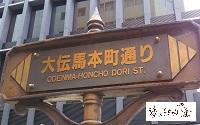 Hello, this is Minato kid. Hello, this is Minato kid.
Today, I would like to walk "Odenma Honcho-dori St." from Nihonbashi Honmachi 3-chome 6 to Nihonbashi Daidenmacho 16.
♪ Otemmacho as a publishing town
In the Edo period, there was a town called "Toyu-cho". It's the 13th area of Odenmacho today. In this area, there were many Shoshi because the play town was close.
In the Genroku era (1688-1704), the scale shop dealing with joruri books, and in the Tenmei era (1781-89), it was a town famous for red-e (a type of ukiyo-e).
In such a town, there was a Shoshido by Juzaburo Tsutaya (1750-1797), a popular publisher in the middle of the Edo period.
Koshodo opened a store in this area in 1783 (1783), and published yellow covers, stylish books (Sharebon), Kyoka books, Nishiki-e, etc. Among them, many leading writers such as Ota Nanbo) and Kyoden Santo (Santo Kyoden), many of the leading players such as Katsushika Hokusai Kitagawa, and many Torakutama.
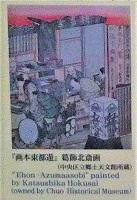 "Higamoto Toyu" Katsushika Hokusai painting "Higamoto Toyu" Katsushika Hokusai painting
The information board of Koshodo is located along the Odenma Honcho-dori St., in the 13th area of Odenmacho.
In addition, one of the publishers who published "Tokaidochu Hizakurige" of Jukkasha 1765-1831, which has a grave in Chuo-ku, is the same Toyu-cho, You can give Jirobei Murataya.
In addition, print shops such as Senzurudo Tsuruya Kiemon, who sold the Edo calendar and Chiyo paintings, and Gun Gyokudo Matsumoto Zenbei, and Matsumodohama Matsuya Kosuke were also famous. Japanese paper is light and durable and not bulky, so these prints were perfect for Edo souvenirs.
 ♪ Otemmacho as a cotton wholesaler district ♪ Otemmacho as a cotton wholesaler district
Another characteristic of Otemmacho is the cotton wholesaler district of the former 1.2-chome.
On the north side of the former Odenmacho 2-chome, there is a mansion from Mikawa country (now eastern Aichi prefecture) and a village headman in Otemmacho. Was. It is said that the townspeople under the control opened a Mikawa cotton wholesaler in the town.
In addition, the Hamacho River, which was once excavated on the east side of Otemmacho, laid the foundation for this town to prosper as a wholesale district. In the late Edo period, "Edo Shopping Sogo Guide" states that there are 22 cotton wholesalers alone.
On the south side of Daidenma Honcho-dori St., there was a street called Daimaru Shindo (Daimaru Jinmichi) in the former Totagocho. As the name implies, in 1743 (1743), a kimono store run by Shoemon Shimomura, Daimaruya opened here.
Since then, Otemmacho has formed a cotton wholesaler area called "Momendana" and boasts its prosperity to this day.
From the Daidenma Honcho-dori St. I walked this time, I could see the Sky Tree straight ahead. Looking back, the other side of the street is the liveliness of Bettara City. Even in the old days of the Edo period, the large store in Otemmacho performed the Ebisu-ko on New Year's Day 20 and October 20.
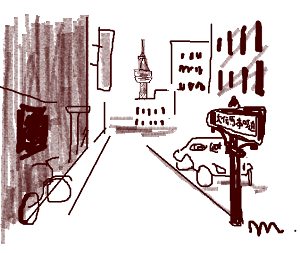
Correspondent Minato kid, Chuo-ku Tourism Association

No. 25 October 22, 2018
[Minato kid]
18:00 on October 9, 2018
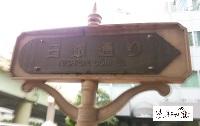 Hello, this is Minato kid. Hello, this is Minato kid.
Today, I would like to walk "Bank of Japan Street" from 4-6 Nihonbashi Honishicho to 1-1 Nihonbashi Muromachi. As the name implies, the Bank of Japan Street is the main building of the main building of the Bank of Japan.
 In accordance with the Bank of Japan Ordinance promulgated in 1882 (1882), the main building of the Bank of Japan began operations as a central bank in Japan. In accordance with the Bank of Japan Ordinance promulgated in 1882 (1882), the main building of the Bank of Japan began operations as a central bank in Japan.
Initially, it was the beginning of using the building of the Hokkaido Kaitaku Savoy Product Sales Office, located at the base of the former Eitai Bridge.
This is a building that displays and sells Hokkaido's specialty products, completed in 1881 (1881), and was designed at Kannarukan, and is a British man Josaiah Condor hired by the Ministry of Construction.
It is a building with a solid and beautiful appearance of the "Venetian Gothic style" and is said to have attracted the attention of people.
 The Bank of Japan moved to its current location in 1896 (1896). It is designed by Kingo Tatsuno, who studied under Condor. The Bank of Japan moved to its current location in 1896 (1896). It is designed by Kingo Tatsuno, who studied under Condor.
"We look into the future and make something solid and magnificent," was the slogan advocated by the then Bank of Japan Governor Koichiro Kawada.
The masonry brick building is said to have been modeled on the Belgian central bank and is considered two masterpieces of Western architecture in Meiji period. In 1974, it was designated as a national important cultural property.
 The main building of the main building of the Bank of Japan is the site of "Kinza" in the Edo period. Koza was the place where the oval casting was performed, and the magistrate was responsible. The main building of the main building of the Bank of Japan is the site of "Kinza" in the Edo period. Koza was the place where the oval casting was performed, and the magistrate was responsible.
Prior to that, there was no foundry called "Temaebuki", and there was no foundry, and under the direction of Gokin Reformer, Shozaburo Goto Koji, the ovalian made their own original gold and passed the Goto family's seal. It was a mechanism to hit the Goto family's seal.
In 1869 (1869), the establishment of the Mint concluded its history with the history of Koza.
Since the Meiji 20s, the Bank of Japan began to set up branches nationwide, and many of them, like the head office, started operating using existing buildings. As the new store of the head office was completed and the business of each store expanded, Shingo Tatsuno created new stores one after another.
♪ Welcome to the sidewalk museum!
Here are some wonderful patterns found on the sidewalk of the Bank of Japan Street.
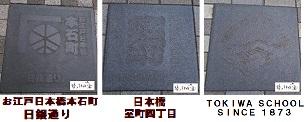
The picture on the sidewalk I found this time was astringent stone, with pride and attachment to the town. From now on, I would like to walk in Chuo-ku, cherishing the encounter with a wonderful sidewalk where you can see the face of the area.
Correspondent Minato kid, Chuo-ku Tourism Association

No. 24 October 7, 2018
|
Links
|
 Hello, this is Minato kid.
Hello, this is Minato kid.
♪ Toysler Memorial Hall
 ♪ U.S.
♪ U.S. ♪ The ruins of Henry Falls residence
♪ The ruins of Henry Falls residence

 In spring, Minatoko likes the appearance of cherry blossom petals floating on the sparkling water surface.
In spring, Minatoko likes the appearance of cherry blossom petals floating on the sparkling water surface.

 The design and construction was considered to be Kisuke Shimizu, and it was a large hotel with a wooden two-story building and 102 guest rooms.
The design and construction was considered to be Kisuke Shimizu, and it was a large hotel with a wooden two-story building and 102 guest rooms. ♪ The entrance to Tsukiji Foreign Settlement
♪ The entrance to Tsukiji Foreign Settlement In 1878 (1878), a Gothic-style red brick cathedral was built. In 1888 (1888), Xiaosei Gakuen originated in the sacred school. However, it was burned down by the Great Kanto Earthquake. The current cathedral was rebuilt in 1927 (1927) under Father Gyrodias.
In 1878 (1878), a Gothic-style red brick cathedral was built. In 1888 (1888), Xiaosei Gakuen originated in the sacred school. However, it was burned down by the Great Kanto Earthquake. The current cathedral was rebuilt in 1927 (1927) under Father Gyrodias. What is preserved in the cathedral is the Angelas bell, nicknamed "Janne Louise of Edo". It was given by Renne, France in 1876 (1876), and was a pair of two large and small bells. Louise is the smaller one. The large Josephine moved to Sekiguchi Church with the Archbishop in 1920 (1920).
What is preserved in the cathedral is the Angelas bell, nicknamed "Janne Louise of Edo". It was given by Renne, France in 1876 (1876), and was a pair of two large and small bells. Louise is the smaller one. The large Josephine moved to Sekiguchi Church with the Archbishop in 1920 (1920).


 Hello, this is Minato kid.
Hello, this is Minato kid.
 ♪ Symbol of Akashicho St. Luke's
♪ Symbol of Akashicho St. Luke's



 The colorful objects on the bridge are inspired by the wind. From this year, a new flower bed at the “Flowering Town Corner” has been set up, and it is a lively street, coupled with the lively traffic of people.
The colorful objects on the bridge are inspired by the wind. From this year, a new flower bed at the “Flowering Town Corner” has been set up, and it is a lively street, coupled with the lively traffic of people. ♪ Characteristics of Tsukiji Foreign Settlements
♪ Characteristics of Tsukiji Foreign Settlements ♪ The brick walls and gas lamps that still remain
♪ The brick walls and gas lamps that still remain brick wall is characterized by a stacking method called "English style".
brick wall is characterized by a stacking method called "English style". There are also gas lamps that are thought to be from the end of the Meiji era.
There are also gas lamps that are thought to be from the end of the Meiji era.
 ♪ Henry Falls and Medical Activities
♪ Henry Falls and Medical Activities
 ♪ Otemmacho as a cotton wholesaler district
♪ Otemmacho as a cotton wholesaler district

 Hello, this is Minato kid.
Hello, this is Minato kid. In accordance with the Bank of Japan Ordinance promulgated in 1882 (1882), the main building of the Bank of Japan began operations as a central bank in Japan.
In accordance with the Bank of Japan Ordinance promulgated in 1882 (1882), the main building of the Bank of Japan began operations as a central bank in Japan.


